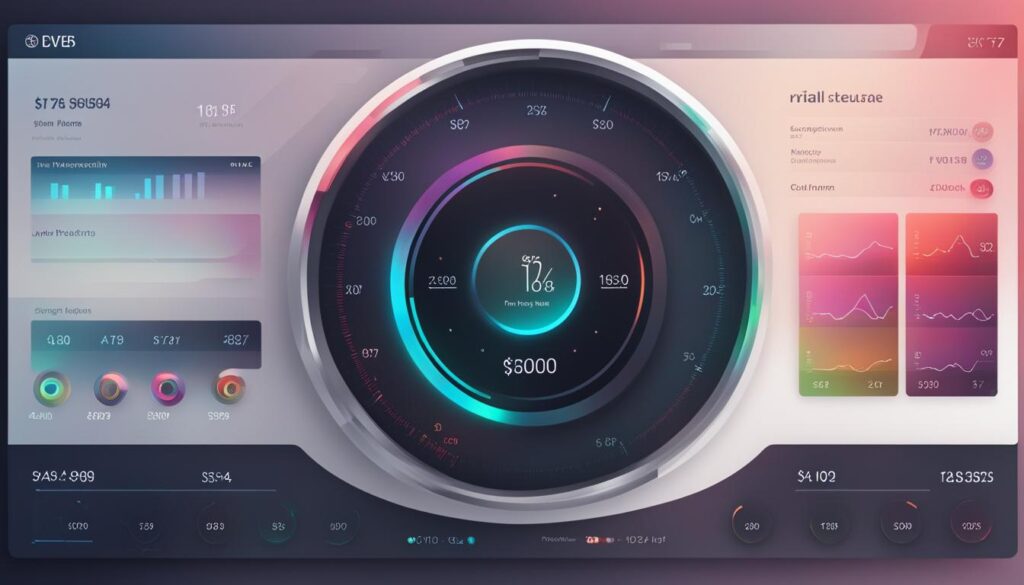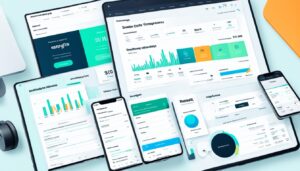Are you looking for ways to optimize your pricing strategies for maximum profitability? With the rise of e-commerce and the increasing competition in online marketplaces, dynamic pricing tools have become essential for businesses to stay competitive.
Dynamic pricing tools, including pricing optimization software and real-time pricing solutions, analyze data to help you make smarter selling decisions. These tools enable you to automate your pricing processes and adjust your prices in real-time based on market conditions and customer behavior.
Key Takeaways
- Dynamic pricing tools help optimize pricing strategies for maximum profitability.
- Pricing optimization software and real-time pricing solutions are two types of dynamic pricing tools.
- Dynamic pricing tools analyze data to make smarter selling decisions.
- These tools enable businesses to automate pricing processes and adjust prices in real-time.
- The use of dynamic pricing tools has become essential in today’s competitive e-commerce environment.
Understanding Dynamic Pricing
Dynamic pricing is a pricing strategy that involves adjusting prices according to real-time market demand, inventory, or other relevant factors. By using dynamic pricing strategies, businesses can stay competitive and maximize their profits. There are different dynamic pricing strategies such as time-based pricing, segmented pricing, and surge pricing that cater to various types of businesses and markets.
Pricing analytics platforms are tools that utilize machine learning algorithms and data analytics techniques to provide insights into customer behavior, market trends, and competitor pricing. By leveraging pricing analytics platforms, businesses can make informed pricing decisions that optimize their revenue and increase their market share.
Dynamic Pricing Strategies
Dynamic pricing strategies can provide businesses with a competitive edge by enabling them to adjust their prices in response to market demand and other relevant factors. Here are some popular dynamic pricing strategies:
- Time-based pricing: adjusting prices according to specific time periods, such as peak hours or seasons.
- Segmented pricing: setting different prices for different customer segments, such as premium and standard customers.
- Surge pricing: increasing prices during periods of high demand, such as ride-hailing services during rush hour.
Pricing Analytics Platforms
Pricing analytics platforms provide businesses with a wide range of tools to manage their pricing strategies. These platforms use advanced algorithms and data analytics techniques to provide businesses with valuable insights into customer behavior, market trends, and competitor pricing. Here are some key features of pricing analytics platforms:
| Feature | Description |
|---|---|
| Real-time data analysis | Provides real-time data analysis to enable businesses to respond quickly to market changes |
| Competitor price tracking | Enables businesses to monitor competitor pricing and adjust their pricing strategies accordingly |
| Price sensitivity analysis | Helps businesses to understand price sensitivity and set profitable pricing strategies |
Benefits of Dynamic Pricing Tools
Dynamic pricing algorithms and algorithmic pricing tools offer numerous benefits to businesses seeking to enhance their pricing strategies. By automating pricing processes, these intelligent tools ensure you stay competitive in a dynamic market.
Increased Efficiency
One of the primary benefits of algorithmic pricing tools is their ability to streamline pricing processes. By automating pricing adjustments based on real-time data, pricing teams can efficiently allocate time and resources towards other important tasks.
Better Decision Making
Dynamic pricing algorithms enable businesses to make smarter pricing decisions based on data-driven insights. With access to real-time information on consumer behavior and market trends, businesses can accurately identify pricing opportunities to maximize sales and revenue.
Improved Competitiveness
By leveraging dynamic pricing algorithms and algorithmic pricing tools, businesses can stay competitive in a constantly evolving market. Real-time pricing adjustments enable businesses to respond quickly to changes in demand and market conditions, ensuring they remain ahead of their competitors.
Overall, dynamic pricing tools offer immense value to businesses seeking to optimize their pricing strategies. By leveraging these intelligent tools, businesses can increase efficiency, make better decisions, and improve competitiveness in a dynamic market.
Real-Time Pricing Solutions for E-Commerce
Real-time pricing is a strategy that allows businesses to adjust their prices in real-time based on changes in market demand, competitor pricing, and customer behavior. This strategy is particularly relevant for e-commerce businesses that operate within a highly dynamic market. Real-time pricing solutions utilize intelligent pricing software that automatically analyses market conditions and sets optimal prices in real-time.
Real-time pricing solutions offer a range of benefits for e-commerce businesses. First and foremost, they enable businesses to stay ahead of their competition by offering competitive prices. Additionally, real-time pricing solutions help businesses maximize their sales and revenue by dynamically adjusting prices to reflect changes in demand and customer behavior. By leveraging intelligent pricing software, businesses can analyze real-time data to identify trends and patterns, thereby optimizing their pricing strategies for maximum profitability.
The image above serves as a visual representation of how real-time pricing solutions work, with data being analyzed in real-time to inform pricing decisions. By leveraging intelligent pricing software, businesses can stay competitive and profitable in an ever-changing e-commerce market.
Pricing Optimization Software for Maximum Profitability
Utilizing pricing optimization software that incorporates dynamic pricing algorithms is crucial in today’s marketplace. These powerful tools analyze customer demand, competitor pricing, and market trends, allowing businesses to optimize their pricing for maximum profitability.
By leveraging pricing optimization software, companies can make data-driven pricing decisions, leading to increased sales and revenue. This software enables the automation of pricing strategies, freeing up time and resources for other critical business functions.
To ensure that your pricing optimization software is delivering maximum value, it is essential to choose a tool that incorporates the most advanced dynamic pricing algorithms. These algorithms take into account numerous factors, including:
- Customer demographics
- Market trends
- Seasonal fluctuations
- Competitor pricing
- Historical sales data
It’s important to note that dynamic pricing algorithms are continuously learning and adapting. They use real-time market data to refine pricing strategies and achieve maximum profitability.
Real-World Examples of Pricing Optimization Software in Action
One example of a business that successfully leveraged pricing optimization software is Amazon. Using dynamic pricing algorithms, Amazon adjusts prices multiple times a day to remain competitive and ensure maximum profitability.
Another company that has benefited significantly from pricing optimization software is Walmart. By analyzing different pricing strategies, Walmart was able to increase its online sales revenue by 35 percent.
Key Features of Dynamic Pricing Algorithms
When searching for pricing optimization software, consider the following key features:
| Feature | Description |
|---|---|
| Real-time market data analysis | This feature enables businesses to receive up-to-date market data to make informed pricing decisions. |
| Data-driven pricing suggestions | Pricing suggestions based on real-time market data and customer behavior. |
| Competitive pricing analysis | Analyze competitor pricing to ensure that your pricing strategy remains competitive. |
| Automated pricing adjustments | The ability to automate pricing adjustments based on real-time market data to achieve maximum profitability. |
Harnessing Data with Dynamic Pricing Tools
Dynamic pricing tools are designed to help you harness the power of data to inform your selling decisions. Automated pricing tools and pricing analytics platforms provide valuable insights into customer behavior, demand patterns, and market trends, enabling you to make data-driven pricing decisions.
With automated pricing tools, you can set rules for pricing adjustments based on demand, competition, and other market factors. Pricing analytics platforms use real-time data to provide valuable insights into customer behavior, enabling you to identify opportunities to increase sales and maximize profitability.
By leveraging these tools you can stay ahead of your competitors, ensuring that your prices remain competitive and profitable in an ever-changing market. The insights provided by pricing analytics platforms and automated pricing tools can also help you identify potential areas for growth, including new markets and product offerings.
Real-world Example:
“By using an automated pricing tool, we were able to identify opportunities to increase sales by adjusting our pricing strategy based on demand. We also used pricing analytics platforms to gain insights into customer behavior, which helped us to optimize our pricing and maximize profitability.”
Key Features to Look for in Dynamic Pricing Tools
Dynamic pricing algorithms and pricing optimization software can transform your pricing strategy, but with so many options on the market, it’s important to know what to look for. Here are the key features to consider when selecting the best dynamic pricing tools for your business:
Real-Time Data Analysis
Real-time data analysis capabilities are critical for effective dynamic pricing. Look for software solutions that can analyze market trends, competitor pricing, and customer demand in real-time. This will enable you to quickly adapt your pricing strategy and optimize your revenue potential.
Advanced Algorithms
Advanced algorithms are the backbone of dynamic pricing software. Look for tools that use machine learning and AI technology to analyze complex data sets and optimize your pricing strategy based on vast amounts of data.
Multiple Pricing Strategies
Not all pricing strategies are created equal – different products, services, and markets require different approaches. Look for software solutions that offer multiple pricing strategies, from cost-plus pricing to value-based pricing and beyond. This will enable you to choose the best approach for your specific needs.
Automated Pricing
Automated pricing tools can help streamline your pricing processes and save you time. Look for solutions that automate pricing changes based on predefined rules and algorithms, freeing up your team to focus on other critical tasks.
Integration
Dynamic pricing tools should integrate seamlessly with your existing systems, including your e-commerce platform and sales channels. Look for software solutions that offer easy integration and implementation, minimizing disruption to your business operations.
Keep these features in mind when selecting dynamic pricing tools, and you’ll be well on your way to building a smarter, more profitable pricing strategy.
Case Studies: Successful Implementation of Dynamic Pricing Tools
Real-world examples have proven the effectiveness of dynamic pricing strategies and algorithmic pricing tools in increasing sales and profitability for businesses.
Business A: Dynamic Pricing Strategies for Revenue Growth
| Challenge | Solution | Outcome |
|---|---|---|
| Business A wanted to increase revenue growth through better pricing strategies. | Implemented an algorithmic pricing tool to automate pricing processes and optimize prices in real-time based on market conditions and demand patterns. | Business A achieved a 10% increase in sales and 15% increase in revenue due to better pricing decisions and increased competitiveness. |
Business A’s implementation of dynamic pricing strategies and algorithmic pricing tools demonstrates the potential for businesses to leverage real-time pricing solutions for revenue growth.
Business B: Algorithmic Pricing Tools for Competitive Edge
| Challenge | Solution | Outcome |
|---|---|---|
| Business B wanted to stay competitive in a dynamic market with fluctuating prices and demand. | Implemented an algorithmic pricing tool to track competitor pricing and automatically adjust prices in real-time to maintain competitiveness. | Business B achieved a 20% increase in sales and 25% increase in revenue due to better pricing decisions and increased competitiveness. |
Business B’s use of algorithmic pricing tools highlights the importance of staying agile and adaptable in a rapidly changing market.
These case studies provide insight into the tangible benefits of leveraging dynamic pricing strategies and algorithmic pricing tools for businesses. By automating pricing processes and utilizing data-driven insights, businesses can optimize their pricing for maximum profitability and competitiveness in today’s dynamic market.
Integration and Implementation of Dynamic Pricing Tools
Integrating dynamic pricing tools, such as real-time pricing solutions and intelligent pricing software, into your existing systems can be a complex process. It’s important to consider the compatibility of these tools with your e-commerce platform or other sales channels to ensure a seamless implementation.
One way to integrate these tools is by leveraging API integrations. These integrations allow the pricing tools to communicate directly with your existing systems, such as inventory management software, to ensure optimal pricing decisions based on real-time data.
Another approach is to use third-party integrations, which act as intermediaries between your pricing tools and other systems. This approach can be useful if your existing systems don’t support direct API integrations. However, it may also introduce additional complexity and potential points of failure.
Considerations for Implementation
When implementing dynamic pricing tools, it’s important to consider a few key factors:
- Overall compatibility with your existing systems and processes
- Level of customization and control over pricing strategies
- Accuracy and reliability of the pricing algorithms
- Integration and implementation costs and timelines
By carefully evaluating these factors, you can ensure a successful integration and implementation of dynamic pricing tools that drive results for your business.
“Effective integration of dynamic pricing tools requires a thorough understanding of your business’s unique systems and processes, as well as the capabilities of the pricing tools themselves.”
Evaluating the ROI of Dynamic Pricing Tools
In today’s dynamic market, optimizing prices is key, and choosing the right dynamic pricing tool can have a significant impact on your bottom line. However, it’s essential to evaluate the return on investment (ROI) of your chosen tool to ensure it’s providing the expected benefits and maximizing profitability.
To measure your tool’s ROI, consider using pricing analytics platforms and automated pricing tools. These tools can provide detailed insights into customer behavior, competitor pricing, and market trends, allowing you to analyze the effectiveness of your pricing strategy and make data-driven decisions.
Using Pricing Analytics Platforms
Pricing analytics platforms offer a comprehensive suite of tools to measure the impact of your pricing strategy on your bottom line. These platforms can provide detailed data analysis, highlighting which pricing strategies are generating the best ROI.
“By implementing a pricing analytics platform, our team was able to analyze our pricing strategy and determine which products generated the most revenue. We were then able to adjust our pricing strategy to maximize profitability and overall revenue.” – John Smith, CEO of ABC Company
Automated Pricing Tools
Automated pricing tools offer powerful automation capabilities, enabling you to apply data insights to your pricing strategy in real-time. These tools can help you respond adaptively to changes in market conditions, ensuring that your pricing strategy is always aligned with your business goals.
“Our team was able to reduce manual pricing adjustments by implementing automated pricing tools. This has not only saved our team time but also increased our bottom line by optimizing our prices on a real-time basis.”
By measuring the ROI of your dynamic pricing tool with pricing analytics platforms and automated pricing tools, you can make data-driven decisions to optimize your pricing strategy and maximize profitability.
Best Practices for Using Dynamic Pricing Tools
Dynamic pricing tools, such as algorithmic pricing software and intelligent pricing tools, can revolutionize your pricing strategy. But to reap their full benefits, it’s important to follow some best practices:
1. Set Pricing Goals
Before implementing dynamic pricing, set clear pricing goals. Determine what you want to achieve with your pricing strategy, whether it’s increasing revenue, market share, or customer loyalty.
2. Understand Your Customers’ Behavior
Use real-time data to analyze customer behavior, including purchase history, browsing patterns, and demographic information. This can help you identify the optimal pricing strategy to attract and retain customers.
3. Monitor Competitor Pricing
Keep a close eye on your competitors’ pricing strategies by leveraging pricing analytics tools. This can help you adjust your pricing in response to market changes and stay competitive.
4. Test and Refine Your Pricing Strategy
Test your pricing strategy by experimenting with different prices, promotions, and discount offers. Continuously analyze the results and refine your pricing strategy to optimize performance.
| Benefits | Challenges | |
|---|---|---|
| Dynamic Pricing Strategies | + Increased revenue + Competitive advantage + Customer loyalty |
– Implementation requires expertise – Risk of price wars |
| Algorithmic Pricing Tools | + Automates pricing process + Real-time data analysis + Improved profitability |
– High implementation costs – Requires robust infrastructure |
| Intelligent Pricing Software | + Real-time response to market + Flexible pricing options + High accuracy |
– Requires sophisticated data management – Interpretation of results requires expertise |
5. Invest in the Right Tools
Choose dynamic pricing tools that fit your business needs and budget. Look for features such as real-time data analysis, advanced algorithms, and compatibility with your e-commerce platform or other sales channels.

6. Train Your Team
Ensure your team is trained on the proper use of dynamic pricing tools. Provide ongoing education to keep them up to date on the latest trends and best practices in pricing optimization.
7. Track ROI
Regularly track and analyze the return on investment (ROI) of your dynamic pricing tools. This will help you identify areas for improvement and measure the impact of pricing optimization on your bottom line.
Following these best practices can help you effectively implement dynamic pricing tools, optimize your pricing strategies, and stay competitive in today’s dynamic market.
Dynamic Pricing Tools Wrap Up
Dynamic pricing tools offer tremendous potential for businesses aiming to optimize their pricing strategies. By leveraging pricing optimization software, real-time pricing solutions, and intelligent pricing software, you can stay competitive, maximize profitability, and make smarter selling decisions in today’s dynamic market.
As with any new tool, implementing dynamic pricing strategies requires careful planning and execution. It is essential to understand the different dynamic pricing strategies, evaluate the ROI of your chosen dynamic pricing tools, and ensure their integration and implementation align with your existing systems.
Moreover, it is crucial to adopt best practices for using dynamic pricing tools effectively, from setting pricing goals to analyzing real-time data. These strategies will help you make the most of your chosen dynamic pricing tools and stay ahead of the competition.
With the right dynamic pricing tools and strategies in place, you can unlock the full potential of your pricing optimization efforts, drive sales, and increase profitability. So what are you waiting for? Start exploring the best dynamic pricing tools available in the market today!
Learn More About Amazon Seller Pricing
FAQ
What are dynamic pricing tools?
Dynamic pricing tools are software solutions that help businesses optimize their pricing strategies based on real-time data and market conditions. These tools use advanced algorithms and analytics to adjust prices dynamically, ensuring competitiveness and maximizing profitability.
How do dynamic pricing tools work?
Dynamic pricing tools work by collecting and analyzing a wide range of data points, including customer demand, competitor pricing, historical sales data, and market trends. Based on these insights, the tools automatically adjust prices in real-time to optimize revenue and drive sales.
What are the benefits of using dynamic pricing tools?
Using dynamic pricing tools provides several benefits, including the ability to stay competitive in a dynamic market, increase sales and revenue, optimize pricing for maximum profitability, automate pricing processes, and make data-driven pricing decisions.
What is the difference between dynamic pricing algorithms and pricing optimization software?
Dynamic pricing algorithms are the mathematical models and formulas that enable the automatic adjustment of prices based on various factors. Pricing optimization software, on the other hand, refers to the comprehensive software solutions that incorporate these algorithms, along with additional features like data analysis, real-time updates, and integrations with e-commerce platforms.
How can real-time pricing solutions benefit e-commerce businesses?
Real-time pricing solutions provide e-commerce businesses with the ability to adjust prices instantaneously based on market fluctuations, competitor activities, and customer behavior. This allows businesses to offer competitive prices, attract more customers, maximize sales, and increase revenue.
What is intelligent pricing software?
Intelligent pricing software is a type of dynamic pricing tool that uses machine learning and artificial intelligence technology to analyze data and make pricing decisions. This software leverages algorithms that learn from past pricing patterns and customer behavior to optimize pricing for maximum profitability.
How do pricing optimization software and dynamic pricing algorithms work together?
Pricing optimization software utilizes dynamic pricing algorithms to analyze various data points, such as customer demand, competitor prices, and market trends. By combining these algorithms with advanced analytics and real-time updates, pricing optimization software helps businesses make informed pricing decisions to maximize profitability.
Can dynamic pricing tools be integrated with existing e-commerce platforms?
Yes, most dynamic pricing tools can be integrated with popular e-commerce platforms, allowing businesses to seamlessly implement real-time pricing solutions and intelligent pricing software. Integration may vary depending on the specific tool and platform, so it is important to check compatibility before implementing.
How can businesses measure the return on investment (ROI) of dynamic pricing tools?
Businesses can measure the ROI of dynamic pricing tools by utilizing pricing analytics platforms and automated pricing tools. These tools provide insights and analytics on the impact of pricing optimization strategies, helping businesses evaluate the effectiveness of their dynamic pricing efforts.
What are some best practices for using dynamic pricing tools effectively?
Some best practices for using dynamic pricing tools include setting clear pricing goals, regularly analyzing real-time data, monitoring competitor pricing strategies, leveraging customer segmentation, conducting A/B testing, and continuously optimizing pricing strategies based on performance metrics.




